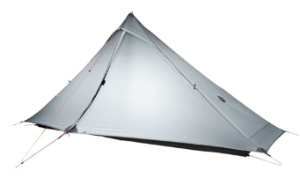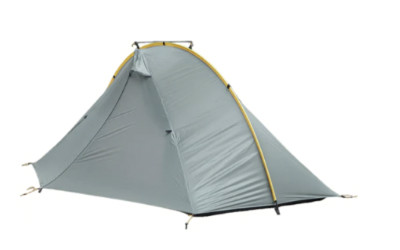Ultralight backpacking tents have become increasingly popular, particularly those made with an ultralight material called Dyneema DCF. Unfortunately, they’ve also become very expensive, putting the lightest weight tents out of reach of most people. But many high-quality ultralight backpacking tents are available today that cost far less than Dyneema ones; they’re still quite lightweight and just as much fun to use. They’re made with more conventional fabrics like siliconized polyester, siliconized nylon, or ripstop nylon with a well-established history of durable use.
If spending an arm and a leg on an ultralight Dyneema DCF tent is out of your reach, here are the 10 Best AFFORDABLE Ultralight Backpacking Tents, both single-wall and double-wall tents, that we recommend.
1. Gossamer Gear “The One”

2. Six Moon Designs Lunar Solo

3. Six Moon Designs Skyscape Trekker

4. Featherstone Backbone 2P

5. Tarptent Protrail

6. 3FUL Lanshan Pro 1

7. Tarptent Rainbow

8. Durston X-Mid 1

9. Durston X-Mid 2

10. 3F UL Lanshan 2

SectionHiker is reader-supported. We only make money if you purchase a product through our affiliate links. Help us continue to test and write unsponsored and independent gear reviews, beginner FAQs, and free hiking guides.
UL Backpacking Tent Selection Guide
The backpacking tent manufacturers who make ultralight tents use a wide range of materials and designs. When shopping for a tent, it’s important to understand the tradeoffs of the models you’re considering and how they can complement your adventures.
Ultralight Tent Materials and Price Points
Trekking poles tents are available in a variety of different materials and at different price points. Dyneema DCF is the lightest weight material and the most expensive, in part because it requires specialized manufacturing processes. Tents made with siliconized polyester (silpoly), siliconized nylon (silylon), and Polyurethane (PU) coated silnylon are much less expensive than Dyneema because they can be sewn using conventional methods. These three fabrics are also roughly comparable in price. It’d be difficult to say which is the best to make tents with because fabric quality varies widely depending on the manufacturer and specification to which it is made. That said, ultralight tentmakers are beginning to switch away from silnylon to silpoly because it has less stretch when it gets wet than silnylon and absorbs less water.
- Tents made with Dyneema DCF are very expensive, but also very lightweight, waterproof, and strong. They are more prone to damage from sunlight over the long term, but that’s seldom an issue for most people. Dyneema tents must be folded when packed not stuffed, but can still be surprisingly bulky despite their low weight.
- Tents made with siliconized polyester (silpoly) are an attractive alternative to Dyneema DCF because they don’t stretch much overnight or when they get wet from rain. They’re also far less expensive and some are seam-taped, so you can use them out of the box without any seam sealing.
- Tents made with PU-coated silnylon are generally more waterproof than regular silnylon, but you need to compare their waterproofing specs to be sure. The chief benefit of the PU coating over regular silnylon is improved UV resistance and the fact that the material can be factory seam-taped.
- Tents made with silnylon are still common because it’s an easy material for manufacturers to work with. While silnylon does stretch at night and when it gets wet, it’s not as big a deal as people make it out to be. Silnylon tents must be manually seam-sealed before they can be used in rainy weather. While you can do this yourself, my advice would be to pay the manufacturer to do it for you so you get a tent that’s ready to be used when it arrives.
Single-wall vs Double-wall Tents
Ultralight backpacking tents are available in single-wall and double-wall models, with separate inner tents. While both are susceptible to internal condensation, the advantage of a double-wall tent is the moisture collects on the underside of the rainfly and not on a wall that has contact with your sleeping bag, quilt, or other gear. The inner tent and rainfly on many double-wall tents can also be used independently from one another, for example as a standalone tarp or as a bug bivy, which can extend their utility. The advantage of a single-wall tent over a double-wall one is usually reduced weight.
If tent condensation ever becomes an issue for you, we recommend carrying a small absorbent face towel to wipe it away. Tent condensation is a small price to pay for reduced gear weight and it won’t kill you unless you’re a witch (wizard-0f-Oz reference).
Headroom
Many ultralight backpacking tents pole tents have a pyramid shape which can limit the amount of headroom and foot room available under the sloping ceiling. Lying on your back and staring at a ceiling that’s three inches from your face can be unpleasantly claustrophobic. Make sure you examine the length of the tents you’re considering, in addition to their peak heights.
Trekking pole tents that require two poles to set up usually have two peaks, which can increase the amount of livable space overhead, compared to a one-pole tent. Some tent manufacturers also reduce the slope of the ceiling to create more headroom. The best example of this is Tarptent’s use of carbon fiber end struts to increase the amount of room under the ceilings at the head and foot ends of their tents. The downside of these end struts is that it can make tents harder to pack horizontally in a backpack.
Vestibules
Vestibules are good for gear storage, especially wet gear storage, and for cooking under cover in windy or rainy weather. Most one-pole tents have a single vestibule, while two-pole tents generally have two. When buying a two-person tent, you’ll definitely want two doors and two vestibules so you can each have your own entrance and gear storage area. It can also be quite useful to have two doors and two vestibules on a one-person tent, especially if you anticipate stormy weather conditions where you might have to hunker down in your tent for a day. For that matter, many people use two-person tents as solo tents, something that’s feasible without a major weight penalty since most ultralight backpacking tents are quite lightweight.
Pole Length
When you choose a trekking pole tent, you want to make sure that it is compatible with the make and model of trekking pole you use if you have a preference. Fixed-length poles that are not adjustable can be difficult to use with trekking pole tents which have very specific height requirements. In addition, you want to make sure that your trekking pole handles are compatible if they have a non-standard grip.
Check Out All of SectionHiker’s Gear Guides!
SectionHiker is reader-supported. We only make money if you purchase a product through our affiliate links. Help us continue to test and write unsponsored and independent gear reviews, beginner FAQs, and free hiking guides.
